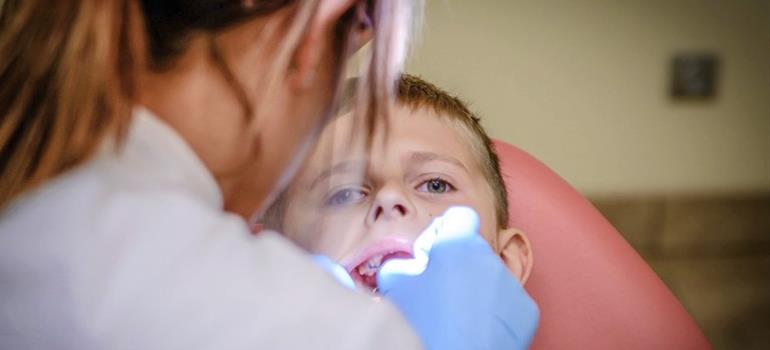[itemWebWizName]
Qty: [itemQuantity]


According to the latest statistics, children in England have already consumed more than twice their recommended sugar intake for this year, with soft drinks remaining the main source of sugar in the average child’s diet.[i] As practitioners know, it is this easy access to sugary food and drinks that is contributing to the so-called children’s oral health crisis in Britain, which has seen thousands of children undergo tooth extractions in hospitals up and down the country.[ii]
This emphasises the need for children to visit the dentist regularly for examinations and professional cleanings, which can help them avoid developing dental caries, but this is often easier said than done. Delivering effective treatment is inevitably more difficult as a result of various factors such as children’s general dislike or fear of the dentist. This is not to say you should be apprehensive about treating children. In fact, the experience can be highly rewarding for them and for you, just by following a few simple steps.
Avoid using “big words”
Dental terminology is confusing even to adult patients, so begin communicating with children using age-appropriate language. For instance, instead of calling them “cavities”, refer to them as “holes in the teeth”. It is also important to avoid using words like “injection” and, instead, say you are “putting the teeth to sleep”. This is a much more descriptive explanation to a child and avoids labels that they may have come across previously and, therefore, might hold negative connotations about treatment. When speaking to children of older ages, be careful not to come across as patronising or you could offend them and this can make it even more difficult to earn their trust, which is an essential part of the treatment process.
Show and tell
Children are more likely to be compliant towards a procedure when they have been told in advance what to expect, and this is particularly relevant in the case of an anxious young patient. As such, practitioners should consider describing procedures in detail, including what the child will probably experience in terms of sight, sound, taste, feel, and smell. In some cases, a child could have difficulty understanding complex verbal explanations so for them, demonstrations or role-play could be a useful strategy to employ.
The tell-show-do method is frequently recommended and involves telling the child what will happen using simple language, and then showing them how the procedure will work – either on themselves or on a model. This is followed through with the proposed procedure, once it is clear that they understand what will happen. By doing this, the child will likely feel more confident that you will do as you say, which can ultimately help you build good rapport with them.
Get down with the kids
In order to earn a child’s trust, it is important for practitioners to interact with them on their level. Approaching them with an energetic attitude, for example, can create a friendly atmosphere in the practice that could put the child at ease, particularly if they are anxious. Engaging with children about their favourite hobbies, cartoons, sports, and celebrity idols can also spur conversation, helping to make them feel more comfortable and distract them from procedures. This will increase the likelihood of the child developing a positive impression of dental care and, in the long term, motivate them towards maintaining good oral hygiene.
Child-friendly practice
In a survey that asked children to choose between two pictures of different practices, 63% of children indicated that they preferred a well-decorated dental clinic over a plain one.[i] These statistics suggest that children’s perception of dentistry is partially influenced by what a practice looks like. This does not necessarily mean you have to invest in grand refurbishment projects for your practice. In fact, replacing everyday items (e.g. cups, gloves, bibs and aspirators tips) with colourful alternatives such as those from the Vibrenté range of dental consumables supplied by Denka, could engage children’s natural curiosity, while helping to promote your practice as a child-friendly environment.
Reward good behaviour
To a child, the best part of a visit to the dental practice is the reward they might get at the end of treatment. It goes without saying that practitioners should avoid providing sweets, but rewards could be offered in the form of stickers, toothbrushes, or little toys, for instance. Gifts such as these can effectively conclude a productive trip to the dentist, serving as good praise to children that behaved well. This is the part of an appointment that most practitioners hope children remember most, as it might influence whether the child comes back to the practice in the future.
Working with children can be challenging, but this is an aspect of dentistry that should be fully embraced. After all, receiving approval from a child for a job well done can make all the hard work worthwhile. In turn, positive interactions can help encourage children to become lifelong patients as they grow into adulthood.
[1] Public Health England. (2018) Children consume more than a year’s worth of sugar in 6 months. Link: https://www.gov.uk/government/news/children-consume-more-than-a-years-worth-of-sugar-in-6-months. [Last accessed: 25.06.18].
[1] The Telegraph. (2018) UK ‘oral health crisis’: 170 youngsters a day have teeth extracted as sugar blamed for epidemic. Link: https://www.telegraph.co.uk/news/2018/01/13/uk-oral-health-crisis-170-youngsters-day-have-teeth-extractedas/. [Last accessed: 25.06.18].
[1] AlSarheed, M. (2011) Children’s Perception of Their Dentists. European Journal of Dentistry. 5(2): 186-190. Link: https://www.ncbi.nlm.nih.gov/pmc/articles/PMC3075993/. [Last accessed: 25.06.18].